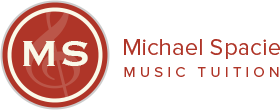Tuition is given in the necessary skills needed to become a competent pianist and to enjoy playing. Instruction is given in all aspects of technique and interpretation. Pianists work from established tutor books and other supplementary materials under tutorial guidance to provide a rich learning musical experience, working at a pace that is comfortable for them. Tuition in music theory is given, as this enables pianists to read and write music with fluency, accuracy, familiarity, and with understanding. Examinations are available in both practical and theoretical subjects for those who require them and these are creative goals. For pianists, these consist of eight graded exams (Grades 1 – 8) followed by the diplomas of the accredited examination boards of The Associated Board of The Royal Schools of Music, Trinity College London and The London College of Music. All these examinations can be taken under Michael’s experienced tutelage with excellent results. Exams, however, are not compulsory and students are encouraged to blossom and flourish beyond the confines of an exam syllabus: learning simply for pleasure is always encouraged and supported, as any playing for pleasure can only come from playing with pleasure. Exam syllabi, while useful, are not a curriculum per se and exams will not be enjoyed or of benefit to every student.
In teaching the piano, all styles are acknowledged and other styles as well as classical are sometimes used. Training is a mixture of learning pieces, practising various aspects of technique, music interpretation, musicianship skills, and learning music theory. Pianists have their lessons using the piano in the tutor’s music room.
When learning the piano, or any instrument, regular practice to build and acquire musical skills – technical, emotional and interpretational is essential in order to make progress and gain musical and personal satisfaction. Helping learners to maintain motivation through challenge is part of the teaching task. A piece of piano music is more than a series of notes in a rhythmic framework or musical structure. As well as general note accuracy, learning to read and play music and the development of a musical ear allowing recognition of musical features is important. Learners should also aim for good tone and phrasing along with appropriate musicality, good posture and hand position, secure technique, and stylistic awareness in a wide range of music. Acquisition of technical skills and teaching musicality with correction of errors in learning enables a student to develop their own musical personality in studying music.
Playing is for pleasure, practice is for progress. Practising is work, but it is interesting work; learning a musical instrument takes a lot of practice and dedication: it is about learning, developing, understanding and achieving skills that you do not already have. Making an effort daily generally produces some good results. There is not enough time in the lesson to do all the practice necessary to succeed; corners cannot be cut when learning and playing the piano. Practice makes progress rather than perfection.
Students learn both technical, musical, creative and notational concepts by playing, hearing and sometimes improvising with technique, rhythms, reading, note playing and artistry. Technique is important and how to develop it on the piano. A student cannot play without technique. Essentially, technical work is preparation for playing pieces rather than an end in itself. Most students want to play tunes and it is important to provide the correct motivational environment by helping them to play musically at whatever level they are able to achieve that. An appropriate level of challenge is essential to maintain good motivation and also maintaining a sense of fun to sustain interest. An introductory lesson is offered in Piano Tuition.
Dr Michael Spacie: Piano Tuition & Music Theory Tuition.

